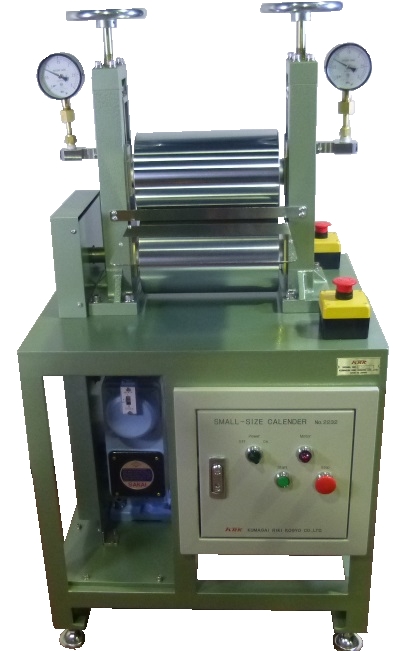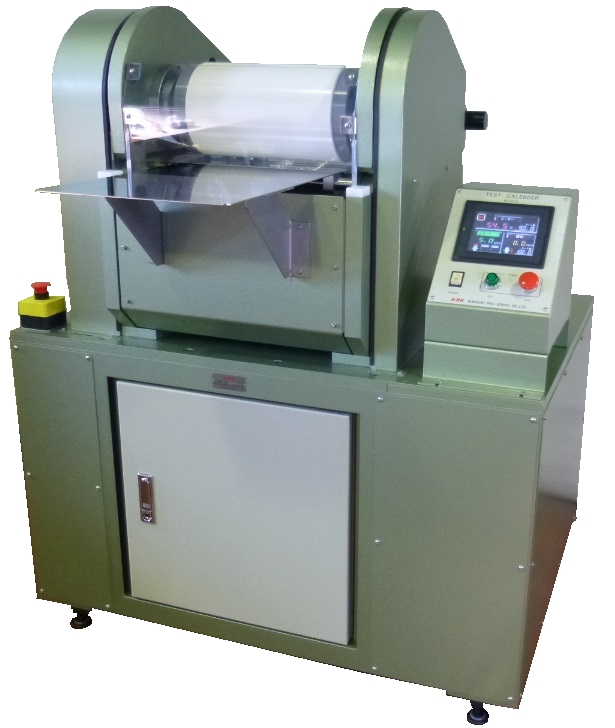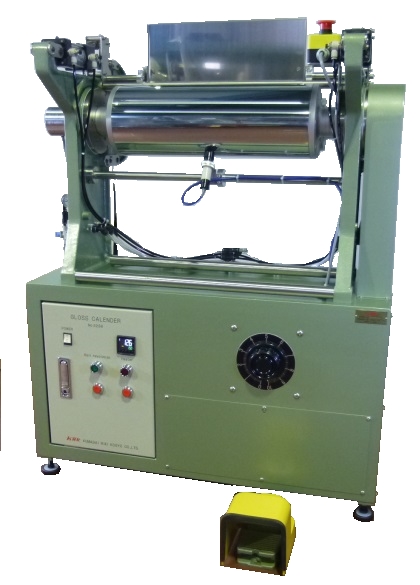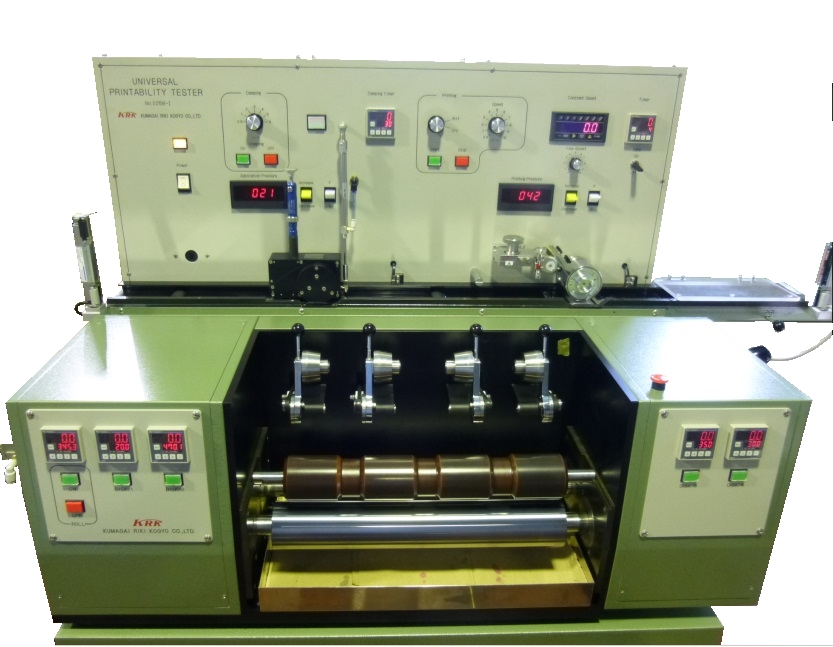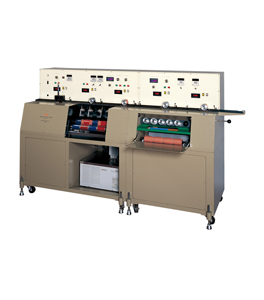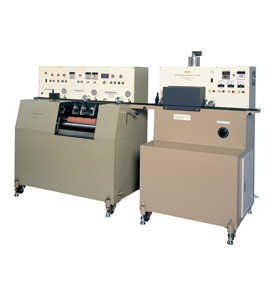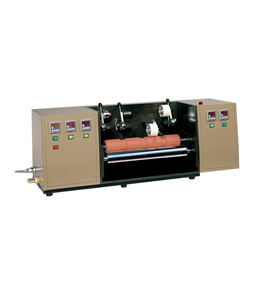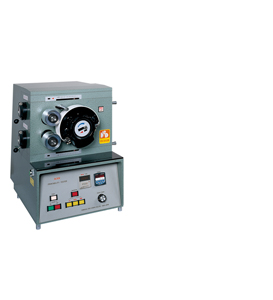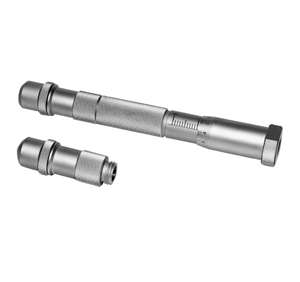The search results of the 「Coat/Calender/Print」
Kumagai Law of Nature Machine
Industrial company > Problem > Coat/Calender/Print
Coat/Calender/Print
紙質の高級化、多様化にともない、要求される品質も多岐多様にわたります。特に塗工や印刷適性、加工に対する要求も高度化しています。その一方で、製造現場においてトラブルが生じるケースも増えています。
熊谷理機工業では、印刷適正や、塗工・加工の工程におけるトラブルを未然に防ぐための試験機をご提供します。
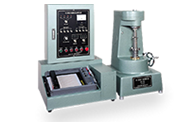
Coat/Calender/Print / Calender
- No.2230_30FC-200E
- [JIS]
- [TAPPI]
- [ISO]
Calendering is performed in the finishing process of raw paper or coated paper. This process gives gloss to paper surface, improves smoothness and adjusts sheet thickness. Various mechanical constructions and roll composition are used for specific purposes. They are classified broadly into three kinds of combination: metal and metal rolls (machine calender), metal and elastic rolls (super calender), and metal and resin rolls (soft or gloss calender). It is desirable to select a test calender most suitable for the intended purpose, considering many items including material used, paper width, linear pressure, temperature, pressurizing method, heating method, sheet paper or continuous paper.
Coat/Calender/Print / Calender
- No.2232
- [JIS]
- [TAPPI]
- [ISO]
This machine is used to adjust the density or smoothness of ordinary paper and handmade paper. It can be easily operated in the laboratory. Machine configuration: provided with two or three hard steel rolls, and a simple hydraulic system; the specimen is pressurized by operating the handle. The paper end is fed into the nip, by sliding the paper placed on the specimen table.
Coat/Calender/Print / Calender
- No.2233
- [JIS]
- [TAPPI]
- [ISO]
This model has easy change roll system.The upper arms which hold and press upper roll can move to outside. Roll is changed in short time. The heating method is High frequency induction heating system.
Coat/Calender/Print / Calender
- No.2238
- [JIS]
- [TAPPI]
- [ISO]
Coated paperboard is calendered in the finishing process after coating. For paperboard thicker than ordinary paper, it is necessary to provide the desired smoothness and gloss while maintaining its bulk. The gloss calender is used to achieve this target, composed of steel roll and rubber roll, thereby ensuring specified quality including white gloss of the coated surface and printability. This simplified machine has been developed by improving the heat calender. It has a roll configuration (steel and rubber) similar to the practical calender, giving heat and pressure to the specimen, thereby offering desired gloss.
Coat/Calender/Print / Printability
- No.2258-I
- [JIS]
- [TAPPI]
- [ISO]
The recent trend is that printing quality is upgraded and use of offset print is diversified. To respond to the requirements in printability with various kinds of paper and ink, a new evaluation method is keenly required from the industry. With conventional printability testers that are distributed widely, there is a problem that it is impossible to control the humidification degree in offset print testing. However, with this machine, the user can try laboratory offset printing by setting various conditions such as simulation of a humidifier, print pressure, printing speed, ink feeding procedure, printing time delay.
The machine features excellent abilities of quantification and reproducibility that allow the user to know properties of various kinds of paper ranging from middle quality paper and newspaper to wood free coated paper. It is useful for study ink transfer, lint, ink drying, trapping and reverse trapping, mottling, etc. The system is composed of two printing units, one offset attachment (humidifier), and one ink mixer to ink the four discs. Each of the two print units is given the capability to adjust printing pressure and set printing speed almost steplessly. It is also possible to set time delay from the first print unit to the second unit, useful for various tests on wet-on-wet basis.
Using this time delay, it is possible to perform set-off test to investigate the transfer of first unit prints onto the back of white paper rolled on the second unit. The inking system of this machine has a temperature-setting range of 15°C to 60°C by circulation of hot water, with the inking rollers divided in four sections to form a uniform film on the printing disc. As for picking test, there are two types available: one is a constant speed test and the other is an accelerated speed-printing test from 0 to 3 meters/second. Accelerated printing can be made linearly independently from printing pressure. In the offset printing process, it is possible that the ink is transferred from the printing disc to the rubber blanket for printing on the paper rolled on the disc. There is also an adjuster to uniformly apply pressure over the printing width, even under the changing printing pressure, increased or decreased.
Reference: 1985 Tappi Coating Conference Proceedings
The machine features excellent abilities of quantification and reproducibility that allow the user to know properties of various kinds of paper ranging from middle quality paper and newspaper to wood free coated paper. It is useful for study ink transfer, lint, ink drying, trapping and reverse trapping, mottling, etc. The system is composed of two printing units, one offset attachment (humidifier), and one ink mixer to ink the four discs. Each of the two print units is given the capability to adjust printing pressure and set printing speed almost steplessly. It is also possible to set time delay from the first print unit to the second unit, useful for various tests on wet-on-wet basis.
Using this time delay, it is possible to perform set-off test to investigate the transfer of first unit prints onto the back of white paper rolled on the second unit. The inking system of this machine has a temperature-setting range of 15°C to 60°C by circulation of hot water, with the inking rollers divided in four sections to form a uniform film on the printing disc. As for picking test, there are two types available: one is a constant speed test and the other is an accelerated speed-printing test from 0 to 3 meters/second. Accelerated printing can be made linearly independently from printing pressure. In the offset printing process, it is possible that the ink is transferred from the printing disc to the rubber blanket for printing on the paper rolled on the disc. There is also an adjuster to uniformly apply pressure over the printing width, even under the changing printing pressure, increased or decreased.
Reference: 1985 Tappi Coating Conference Proceedings
Coat/Calender/Print / Printability
- No.2258-II
- [JIS]
- [TAPPI]
- [ISO]
This system has two sets of 2-color press of standard type, capable of printing on wet-on-wet basis: this machine is designed most suitably to grasp the behavior of color printing in the process of commercial off-set press. For set-off test, it is possible to set three stages of time delay at a time for effective testing.
Coat/Calender/Print / Printability
- No.2258-III
- [JIS]
- [TAPPI]
- [ISO]
With this machine, the specimen is dried when being put in the drying oven, and it is possible to test drying behaviors of specimens different from when subject to natural drying. This machine is also used for blistering test.
Coat/Calender/Print / Printability
- No.2259
- [JIS]
- [TAPPI]
- [ISO]
This is an ink kneader with separate portions for the universal printability tester. After ink is supplied, push the button to automatically knead the ink, and move the printing disc to ink the roll. The time length of kneading and inking is set by the timer. The temperature of the ink kneading roll can be controlled by connecting it to the constant temperature water tank.
Coat/Calender/Print / Printability
- No.2260
- [JIS]P-8129-1998
- [TAPPI]
- [ISO]3783
Printability testers are used not only for papers, but also for sheet like materials such as metallic plates and plastic sheets. This tester is designed to set thickness of ink, printing pressure and printing speed as desired, with three functions of accelerated printing, constant speed printing and interrupted printing. The machine is of two-shaft type for process printing, with a range of 0.1 sec. to 6 sec. between the firs print and second print. This is a process printing tester to offer effective data by simulating the conditions of a practical process printing press. Because of featuring a high precision, in the accelerated printing mode, the printing speed changes linearly.
Coat/Calender/Print / Printability
- No.2264
- [JIS]P-8129-1998
- [TAPPI]UM 591
- [ISO]
For the process of print testing, correct ink sampling is an important factor affecting test precision and test reproducibility. This pipette is used to sample a small amount of printing ink to be fed to the ink kneader, and with this pipette, it is possible to perform correct testing. The structure of the pipette allows the ink to be charged from the top end to the cylinder section. Reading the scale of the micrometer, squeeze the ink from the top cap by turning a screw that is linked to the plunger. The pipette can be disassembled to facilitate cleaning.

